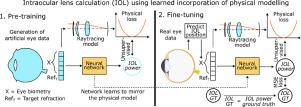Medical Image Analysis ( IF 10.7 ) Pub Date : 2021-11-27 , DOI: 10.1016/j.media.2021.102314 Hendrik Burwinkel 1 , Holger Matz 2 , Stefan Saur 2 , Christoph Hauger 2 , Michael Trost 3 , Nino Hirnschall 4 , Oliver Findl 4 , Nassir Navab 5 , Seyed-Ahmad Ahmadi 6

|
The human cataract, a developing opacification of the human eye lens, currently constitutes the world’s most frequent cause for blindness. As a result, cataract surgery has become the most frequently performed ophthalmic surgery in the world. By removing the human lens and replacing it with an artificial intraocular lens (IOL), the optical system of the eye is restored. In order to receive a good refractive result, the IOL specifications, especially the refractive power, have to be determined precisely prior to surgery. In the last years, there has been a body of work to perform this prediction by using biometric information extracted from OCT imaging data, recently also by machine learning (ML) methods. Approaches so far consider only biometric information or physical modelling, but provide no effective combination, while often also neglecting IOL geometry. Additionally, ML on small data sets without sufficient domain coverage can be challenging. To solve these issues, we propose OpticNet, a novel optical refraction network based on an unsupervised, domain-specific loss function that explicitly incorporates physical information into the network. By providing a precise and differentiable light propagation eye model, physical gradients following the eye optics are backpropagated into the network. We further propose a new transfer learning procedure, which allows the unsupervised pre-training on the optical model and fine-tuning of the network on small amounts of surgical patient data. We show that our method outperforms the current state of the art on five OCT-image based data sets, provides better domain coverage within its predictions, and achieves better physical consistency.
中文翻译:

眼科中的物理感知学习和特定领域的损失设计
人类白内障是人类眼睛晶状体的一种发展中的混浊,目前是世界上最常见的失明原因。因此,白内障手术已成为世界上进行最频繁的眼科手术。通过移除人类晶状体并用人工人工晶状体 (IOL) 替换它,可以恢复眼睛的光学系统。为了获得良好的屈光效果,必须在手术前精确确定 IOL 规格,尤其是屈光力。在过去几年中,已经有大量工作通过使用从 OCT 成像数据中提取的生物特征信息来执行这种预测,最近还通过机器学习 (ML) 方法。迄今为止的方法只考虑生物特征信息或物理建模,但没有提供有效的组合,同时也经常忽略 IOL 几何形状。此外,在没有足够领域覆盖的小数据集上进行机器学习可能具有挑战性。为了解决这些问题,我们提出了 OpticNet,这是一种基于无监督、特定领域损失函数的新型光学折射网络,它明确地将物理信息整合到网络中。通过提供精确且可区分的光传播眼睛模型,跟随眼睛光学的物理梯度被反向传播到网络中。我们进一步提出了一种新的迁移学习程序,该程序允许对光学模型进行无监督预训练,并对少量手术患者数据进行网络微调。我们表明,我们的方法在五个基于 OCT 图像的数据集上优于当前最先进的技术,在其预测中提供更好的域覆盖,











































 京公网安备 11010802027423号
京公网安备 11010802027423号